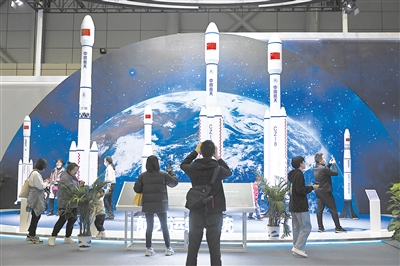
 |
| Visitors take photo of rocket models at a Space Day of China science exhibition in Hefei, east China's Anhui province, April 24, 2023. (PHOTO: XINHUA) |
China released global color images of Mars obtained from its first Mars exploration mission, as part of the festivities of celebrating the Space Day on April 24, Singapore's Lianhe Zaobao reported.
The images were created using mapping standards with a spatial resolution of 76 meters. They show the eastern and western hemispheres of Mars in orthographic protection, the Robinson projection of Mars, and the Mercator projection plus an azimuthal projection of the planet.
Starting from May 1, 2023, the scientific data of Tianwen-1 will be open to the world, said Zhang Rongqiao, the chief designer of China's first Mars exploration mission.
Growing by leaps and bounds
In 2016, China designated April 24 as Space Day of China, in memory of the launch of its first satellite "Dongfanghong-1" into space on April 24, 1970. Since becoming the third country to launch a human into space in 2003, the country has never ceased its dedication to space exploration.
In 2019, China made history as the first country to land on the far side of the moon. By the end of 2020, the Chang'e-5 probe successfully returned with rock and lunar soil samples, further showcasing the country's advancing power in space.
In recent decades, the Chinese space program has developed at an incredibly fast pace, turning the country into a comprehensive space power behind only the U.S. in terms of accomplishments and capabilities, said The Japan Times.
According to a report released by the Office of the Director of National Intelligence in August 2022, the U.S. predicted that China would surpass its space capabilities by 2045.
U.S. Space Force Lt. Gen Nina Armagno echoed the remarks, saying: "It's entirely possible they could catch up and surpass us, [and]the progress they've made has been stunning -stunningly fast," according to The Guardian.
China's space program has been growing by leaps and bounds, said Brown University Professor James Head, citing the country's achievements in human and robotic exploration, and a string of successes on the moon and Mars.
Promoting international collaboration
Besides notable progress made in space exploration, China has always actively promoted international collaboration.
China and France will join hands in cooperation between their space institutions for the Chang'e-6 lunar probe and joint studies of extraterrestrial soil and rock samples, according to a joint declaration released by the two countries during French President Emmanuel Macron's state visit to China in April.
Russia's space agency Roscosmos and China National Space Administration inked a deal in 2022 to stipulate bilateral space cooperation in 2023-2027, reported by Russian news agency Tass.
The country also unveiled a plan for the construction of the International Lunar Research Station initiated by China and extended an invitation to organizations and scientists around the world to participate in the program on April 25.
The building of the station will be carried out in three phases, with a basic model of the station expected to be completed by around 2030, said Wu Weiren, chief designer of China's lunar exploration program. China is also making a national plan to promote its space science development in areas such as research on habitable planets, biological and physical sciences in space and encouraging international collaboration in these missions, according to National Space Science Centre.
Voice of the World
Edited by TANG Zhexiao


 Next
Next




